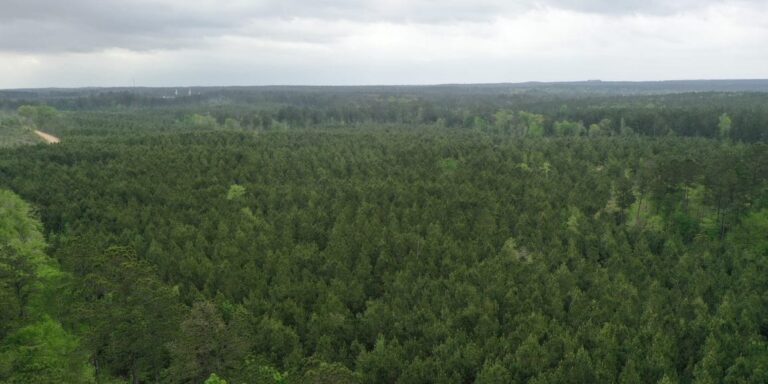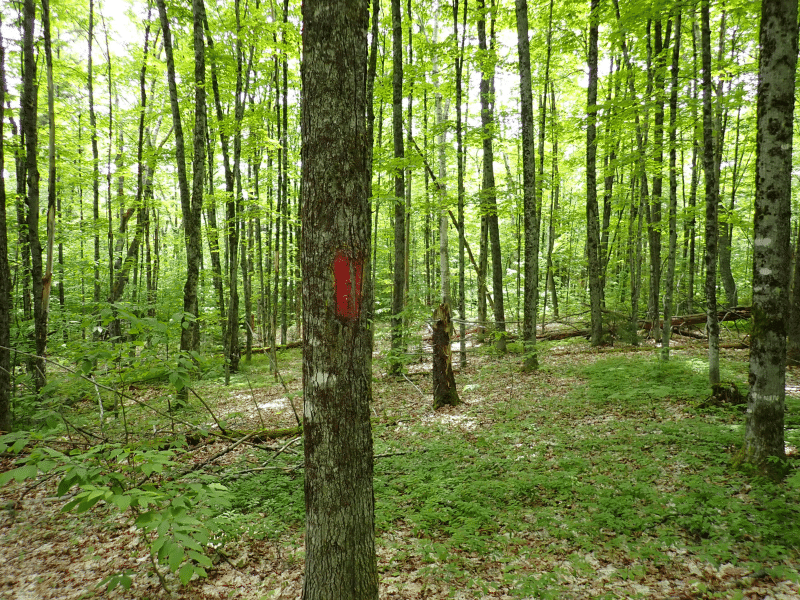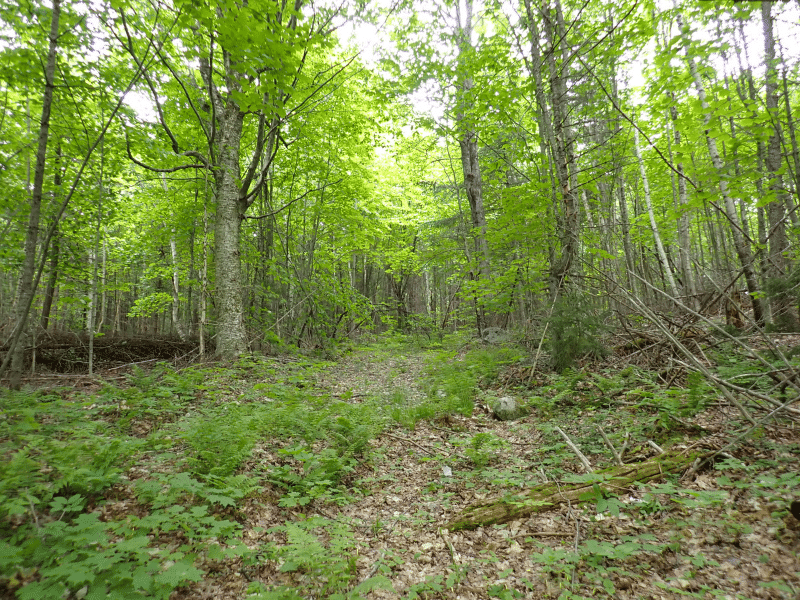Powder Spring Forest
Property Details
Property Overview
The property features opportunities to take over an attractive, long-term investment, which has been well-managed over time for high-quality northern hardwood timber. Potential building sites can also be easily found throughout the land.
Notable highlights include:
- Managed timber resource, well-positioned for future volume and value growth;
- Sugar maple-dominated timber resource worth around $579,300;
- Sugarbush management and development potential, owing to 40% stocking of sugar maple and excellent slopes;
- Developed internal forest road access;
- Desirable location in central Vermont, close to population centers such as Barre and Montpelier, and close to Interstate 91.
Location
Powder Spring Forest is located in north Topsham, Vermont, a rural town in Orange County mostly consisting of forested acreage, farms, and small homesteads. The town is situated just east of the Green Mountains and west of the Connecticut River Valley, characterized by rolling hillslopes and many rivers, including the Waits, which drains east into the Connecticut River, and the Powder Spring brook, from which this forest gets its name.
While Topsham exemplifies the character of rural Vermont, with its peaceful ambiance and quaint rural character, the town and the subject property are easily connected to local population centers and amenities. Vermont Route 25 and U.S. Route 302 serve to connect Topsham with Barre to the northwest (25 miles away), Bradford (12 miles away to the southeast), and St. Johnsbury (31 miles northeast). In Bradford, there is access to Interstate 91, a major travel corridor connecting Vermont to Massachusetts and Canada, and in Barre, there is access to Interstate 89, connecting to major cities and cultural centers of Burlington, VT, and Manchester, NH. Boston, MA, and Hartford, CT, are a 3-hour drive south.
Access
Legal access to Powder Springs Forest is provided by several modes, including Town Class 3 & 4 roads and private access points.
Powder Spring Road provides a point of access to an old woods road that parallels the brook. This former roadway provides sufficient access to the land’s extreme eastern slopes as they tilt to the brook. This small region of the forest supports an attractive 35 to 45-year-old sugar maple stand.
Sanborn Road offers frontage for a driveway point permitting access to another small section of the forest which slopes to the east.
Currier Road is the primary access point to the forest, which leads to a 1,600’ section of class 4 road before entering the southern section of the property. Once on the property, a developed internal road runs 2,600’ to a log landing which provides access to all of the property’s western higher elevation. Another internal road runs nearly 3,600’ to the east and then north, providing functional access to the land’s entire eastern half. Both roads can be seen on the property photo maps.
Frost Road provides legal Class 4 access to a small section of the northern end of the property. However, this area has traditionally been accessed from the established roads that originate on the southern side of the forest.
Property Description
The property has been shaped by its former uses, including an intensive period of farming and homesteading going as far back as the late 1700s. Field evidence, such as barn and house stone foundations, stone walls ,and wire fences, covers the property’s landscape, indicating that nearly all of the land was formally used for some form of agricultural activity. Following abandonment in the late 1800s, as the country grew more industrialized, the farmlands were steadily abandoned and allowed to grow back to forest.
The property is situated in a generally high-elevation region of Vermont. The land is characterized by several hills, ravines, and drainages which offer aspects in all directions. The southern and eastern-facing hillsides especially would benefit from tree clearing in order to maximize potential views, which would offer vistas of the White Mountains to the east. Elevation ranges from around 1,500’ near Powder Springs Road, where the land rises up a prominent hillside (1,900’) before falling again to the west, where flatter land contains wetlands and low-lying creeks. Headwater streams of Powder Springs Brook are found here, running through the property heading south.
Slope conditions on the property are rolling and moderate overall, and the terrain is easily accessible by foot or via logging equipment during forest management.
Timber Resource
Timber data in this report are based on a timber inventory conducted in December 2022, with the purpose of establishing Capital Timber Value (CTV) by F&W Forestry Services, the owner’s forest manager. 91 inventory points were sampled (1 plot per 5.4 acres), covering a 486’ X 486’ grid using a 15-factor prism. Sampling statistics are ±13.4% standard error for sawlog products and +/-7% for all products combined at the 95% confidence interval. Upon applying growth for 1 season at regional FIA data growth rates, the timber data reveal a total sawlog volume of 2,243 MBF (Intl’ ¼” scale) (4.4 MBF/acre), with 6,435 pulpwood cords (13.0 cords/acre). Combined total commercial per acre volume is 18 cords, a figure about average for the region. Stumpage values were assigned to the volumes in May of 2024, producing a property-wide Capital Timber Value (CTV) of $566,100 ($1,143/acre). See the Timber Valuation in this report for details.
Species Composition:
The species composition is 84% hardwoods and 16% softwoods. Species composition for all products combined is led by sugar maple (44%), followed by yellow birch (12%), white ash (9%), and red maple (8%). Softwood volume mainly consists of spruce/fir (8%) and pine (3%). Scattered red pine is also found in some areas of the forest. The sawlog volume breakdown is led by sugar maple (46%), followed by spruce/fir (14%), and yellow birch (13%), along with small levels of various common associates. The primary species all have benefited from strong historical (and current) markets for their various end products, ensuring the likelihood of robust asset appreciation from stumpage price growth.
Stocking and Stem Quality:
Stocking is variable due to past timber harvesting, which has targeted various areas of the property. Much of the property is found as mature, even-aged forest, while other acreage has been harvested and is now a less dense overstory growing atop a dense understory. Basal areas in the stands range from 40-120 ft2/ac, and show 69% Acceptable Growing Stock.
Sawlog Value/ Management History:
Sawlog value is dominated by sugar maple (46%) followed by spruce/fir (14%) and yellow birch (13%), with the small balance held by red maple, white ash, and others.
The 2023 forest management plan identifies fifteen forest stands. Most stands have been harvested in the past two decades using a combination of shelterwood, group selection, and overstory removal harvesting. The most recent harvesting on the property occurred in 2018.
Diameter Distribution:
The diameter distribution indicates a wide range, with strong representation from advanced saplings established during harvesting over the years. Poletimber in the 6-10” diameter range is also well-represented. The diameter distribution clearly shows the results of a managed forestland, with the bulk of the stocking being found in small logs and large poletimber nearing sawlog size.
Sugarbush Option
The timber data indicates a total of 16,400 potential maple taps from the 9” and greater size classes, with 84% of the taps from sugar maple and the balance red maple. Tap density per acre is variable, ranging from around 20 per acre in previously harvested areas to 60-70 in more dense hardwood stands. Sugaring use would be an excellent additional income source if portions of the property were given over to taps. Electrical power is available a short distance from the property on Currier Road or on the Powder Spring Road, and slopes offer a diverse aspects for multiple setup options.
Parcel Map
Broker Disclosure: Under agency law, you are considered a customer, unless you have a written brokerage agreement with Fountains Land (in which case you are a client). While you are a customer, Fountains is NOT obligated to keep confidential the information that you might share with us; therefore, you should not reveal any information that could harm your bargaining position.

Zach Jaminet
Vermont & New Hampshire Real Estate Agent
Contact Zach Jaminet
Resources
Maps
-
Google Earth IconGoogle Earth
-
Locus Map IconLocus Map
-
Topo Map IconTopo Map
-
IR Map IconIR Map
-
Photo Map IconPhoto Map
View Similar Properties
-
 Available$106,807
Available$106,807Denning Pines Tract #1
11 AcresTimberlandDenning, San Augustine County, TX -
 Available$73,111
Available$73,111Denning Pines Tract #2
6 AcresTimberlandDenning, San Augustine County, TX -
 Available$127,252
Available$127,252Denning Pines Tract #3
13 AcresTimberlandDenning, San Augustine County, TX -
 Available$167,544
Available$167,544Denning Pines Tract #4
17 AcresTimberlandDenning, San Augustine County, TX

















